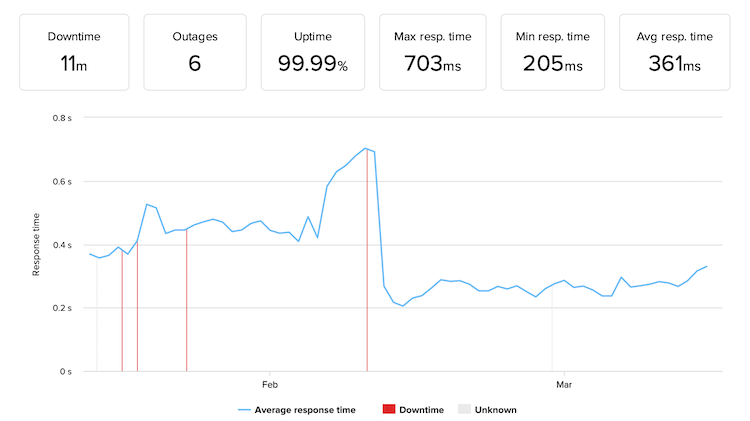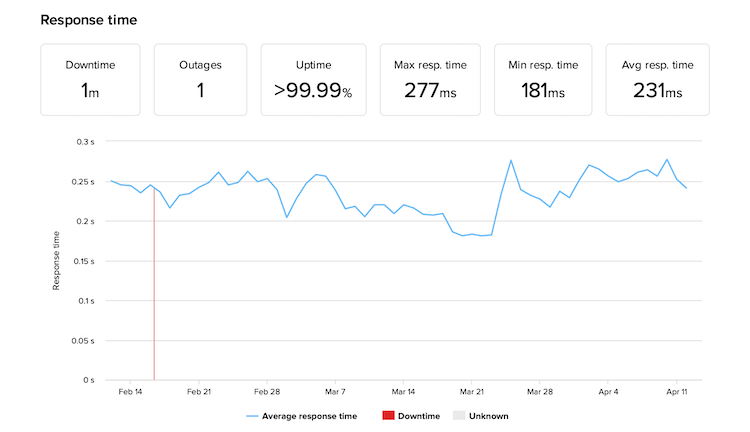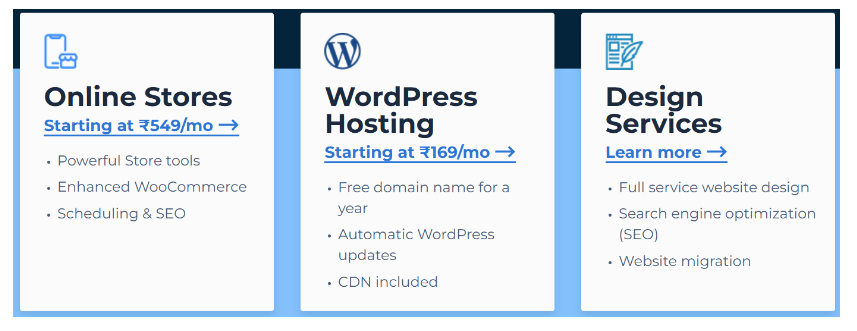Bluehost vs DreamHost – “The Winner Is …”
Bluehost is a well-known web hosting provider, particularly recommended by WordPress.org. It offers various services, including shared, VPS, and dedicated hosting, with features like free domain registration, SSL certificates, and 24/7 support. Its user-friendly interface is ideal for beginners, especially those using WordPress.
DreamHost, founded in 1997, is recognized for its performance and reliability, focusing on cloud hosting and managed WordPress services. It offers shared, VPS, dedicated, and cloud hosting with a 97-day money-back guarantee. DreamHost is praised for transparent pricing and provides unlimited bandwidth and storage on many plans.
In terms of pricing, Bluehost typically has lower introductory rates, although renewal costs can be higher. DreamHost offers clear pricing with no hidden fees. Both companies provide solid support, with DreamHost known for its knowledge base and ticket system, while Bluehost offers live chat and phone support.
Bluehost
Performance: |5.0|
Bluehost offers reliable performance, especially for WordPress sites, with a 99.9% uptime guarantee. Its servers are optimized for speed, ensuring quick loading times, though some users report occasional slowdowns during peak traffic.
Uptime: |4.9|
Bluehost guarantees a 99.9% uptime, ensuring that websites remain accessible most of the time. While it generally performs well, some users have reported occasional slowdowns during peak traffic periods.
Customer Service: |4.8|
Bluehost provides 24/7 customer support through live chat, phone, and a ticketing system. Their team is responsive and helpful, especially for beginners, and they also offer a comprehensive knowledge base with tutorials for self-help.
DreamHost
Performance: |4.8|
DreamHost excels in speed and uptime, often achieving 100% uptime for shared hosting. Its cloud infrastructure supports scalability, making it ideal for fluctuating traffic. Advanced caching options and optimized server configurations further enhance loading times and overall performance.
Uptime: |4.9|
DreamHost commits to 100% uptime for shared hosting, making it a reliable choice for websites with fluctuating traffic. This strong uptime record is supported by its robust cloud infrastructure and advanced technologies, which contribute to overall site reliability.
Customer Service: |4.7|
DreamHost offers 24/7 support mainly via live chat and a ticketing system, as they do not provide phone support. Their knowledgeable team resolves issues quickly, and an extensive knowledge base allows users to find answers independently.
Both providers prioritize customer satisfaction, with Bluehost appealing to those who prefer direct communication, while DreamHost caters to users comfortable with self-service resources.
Overall Comparison Bluehost vs DreamHost
Here's a high-level overview of Bluehost vs. DreamHost
For those seeking a straightforward way to launch a WordPress site, Bluehost is the top choice.

After testing its website builder, we found it to be more versatile and customizable than those offered by other hosts, while still being remarkably user-friendly. Anyone can create a website that looks and works exactly as they envision.
Alternatively, if you prefer a streamlined, secure, and easily scalable experience, DreamHost is an excellent choice. Their hosting plans are simple, offering just two clear options for shared hosting, so there’s no confusion over which plan will suit you best.

Whether you’re looking for shared hosting, a developer-friendly virtual private server (VPS), or fully managed VPS hosting, DreamHost prioritizes security and simplicity.
You’ll also benefit from fewer upsells and ads, hassle-free cancellations, and more affordable scaling options as your needs expand.
| Aspect | Bluehost | DreamHost |
|---|---|---|
| Established | 2003 | 1997 |
| Type of Hosting | Shared, VPS, Dedicated | Shared, VPS, Dedicated, Cloud |
| Recommended By | WordPress.org | WordPress.org |
| Uptime Guarantee | 99.9% | 100% |
| Free Domain | Yes, for the first year | Yes, for the first year |
| SSL Certificate | Free | Free |
| Customer Support | 24/7 via live chat and phone | 24/7 via live chat and ticketing |
| Money-Back Guarantee | 30 days | 97 days |
| User-Friendliness | Beginner-friendly with easy setup | Intuitive dashboard with advanced features |
| Notable Features | One-click installs, marketing credits | Cloud hosting options, SEO tools |
1. Plans and Pricing
Bluehost’s shared hosting starts at $1.99/month, slightly pricier than DreamHost’s entry-level plan at $2.59/month. Both providers offer comparable scalability options at similar price points, including Managed WordPress, VPS hosting, and dedicated servers.
| Plan Type | Bluehost | DreamHost |
|---|---|---|
| Basic | $2.95/month | $2.59/month |
| Plus | $5.45/month | $3.95/month |
| Choice Plus | $5.45/month | $4.95/month |
| Pro | $13.95/month | $16.95/month |
| Managed WordPress | $9.95/month | $16.95/month |
| VPS | Starting at $19.99/month | Starting at $15.00/month |
| Dedicated | Starting at $79.99/month | Starting at $149/month |
For most users, shared hosting is the preferred choice. A quality hosting provider should be able to accommodate both small personal sites and medium-sized business websites on shared servers, which is why this article focuses on this option.
Both Bluehost and DreamHost offer a free domain, SSL certificates, unmetered bandwidth, and 50GB SSD storage for a single website in their entry plans. However, there are key differences in features:
Bluehost’s Basic plan ($1.99/month) includes unlimited email accounts in addition to the standard features.
DreamHost’s Starter plan ($2.59/month) doesn’t include email accounts but provides daily backups and domain privacy.
Despite the lack of email accounts, DreamHost offers a stronger feature set and is less expensive overall. Daily backups and domain privacy alone could easily be worth an extra $30 per year.
However, like most hosting providers, both Bluehost and DreamHost require the longest billing term to secure the lowest rates, with prices rising after the initial term. Notably, DreamHost remains the more affordable option both at the advertised and renewal rates.
It’s also important to note that while these entry-level plans offer useful features, they come with limitations. For instance, if you need to host multiple websites, exploring other plans is advisable.
2. Features
Bluehost and DreamHost are two major players in web hosting, with only subtle differences at a high level.
Bluehost stands out for its beginner-friendly features, ease of use, and responsive customer support. DreamHost, meanwhile, excels with strong server performance, a commitment to security and privacy, and budget-friendly scalability options.
Ultimately, the choice between them comes down to the finer details. Both can be excellent options, though each has specific features worth considering as you look closer.
| Features | Bluehost | DreamHost |
|---|---|---|
| Free | Free domain registration for the first year | Free domain registration for the first year |
| Storage | Starts at 10 GB SSD | Fast SSD |
| SSL Certificate | Free SSL certificate | Free SSL certificate |
| Subdomains | 10 free subdomains on the base plan | Free subdomain |
| Bandwidth | Unlimited bandwidth on most plans | Unlimited bandwidth and storage |
| Automatic Backups | Available on the Choice Plus plan and higher | Available |
| Website builder | Available (AI site creation tool) | Available (WP website builder) |
| Email Hosting | Free trial for 3 months available | No free trials |
| uptime guarantee | 99.9% uptime guarantee | 100% uptime commitment |
| installation | One-click WordPress installation | Managed WordPress hosting options |
| Money-Back Guarantee | 30-day money-back guarantee | 97-day money-back guarantee |
| Easy-to-use | Easy-to-use website builder | Advanced cloud hosting options |
| SEO tools | Marketing credits for advertising | SEO tools included |
| hosting plans | Multiple hosting plans (shared, VPS, dedicated) | Multiple hosting plans (shared, VPS, dedicated, cloud) |
| Support | 24/7 customer support (live chat, phone) | 24/7 customer support (live chat, ticket) |
Both providers offer a strong lineup of features. Consider the potential use cases and subtle pricing differences.
3. Performance
Bluehost vs. DreamHost Performance
In terms of performance, DreamHost proves to be more dependable, faster, and robust. Over long-term monitoring, it demonstrated slightly better uptime, faster loading speeds, and the ability to manage higher traffic volumes than Bluehost.
In this segment of the Bluehost vs. DreamHost comparison, I closely examined the performance of both.
Uptime and Response Time
After two months of monitoring, both providers showed strong reliability, though DreamHost experienced fewer outages.
Bluehost’s uptime reached 99.9%, with a total of 11 minutes of downtime across six outages—an impressive result for shared hosting.

In terms of speed, Bluehost servers are also quite fast, with an average response time of 361ms. Notably, response times improved in the latter half of testing, aligning with the timing of the outages, suggesting Bluehost is actively addressing issues to minimize user impact.
Meanwhile, DreamHost exceeded expectations, achieving better-than-100% uptime with only a single, one-minute outage. For a provider that guarantees 100% uptime, this is an outstanding result.

DreamHost also excelled in response time, averaging 231ms—an impressive result for shared hosting.
Overall, both providers show strong reliability, with DreamHost being marginally faster and more consistent.
Website Speed
In terms of website speed, DreamHost again leads slightly. We focused on three key metrics in this comparison:
Largest Contentful Paint (LCP): This indicates when the largest piece of content loads, signaling to users that the page is loaded. The optimal LCP is less than 2.5 seconds.
Fully Loaded Time: This is when the site finishes loading and is fully functional.
Time to First Byte (TTFB): The initial server response time, showing whether any delays are due to the provider or website theme.
For Bluehost, the LCP on a fully-built website is 1.8 seconds, well within the recommended 2.5 seconds, though it’s not the absolute fastest possible.

While Bluehost’s LCP isn’t extraordinary, there’s no additional delay after this point, making the 1.8-second load time an impressive result.
However, the TTFB shows room for improvement, with the server taking a full second to respond to the initial request. Without this delay, Bluehost’s website load time could be under a second.
DreamHost performs slightly better in comparison, with an LCP of 1.4 seconds, offering a faster load time. While not industry-leading, this result is still very solid.

Regarding Fully Loaded Time, DreamHost has a slight delay, clocking in at 1.6 seconds—very similar to Bluehost’s result.
The main difference lies in TTFB, where DreamHost responds significantly faster to the initial request.
Overall, DreamHost edges out Bluehost in speed, but the difference is relatively minor.
4. Ease of Use
Right off the bat, Bluehost is much more beginner-friendly than DreamHost. It provides two dashboards—one for standard settings and a cPanel for advanced tools. DreamHost, in contrast, offers a single dashboard that may take some time to get accustomed to.
To be clear, DreamHost’s dashboard includes all the essential tools. However, new users may need some time to learn its navigation.
Since ease of use can mean different things, I’ll be examining the user interfaces, control panels, and website builders individually to give you a clearer view of what each provider offers.
Bluehost
User-Friendly Interface: Bluehost provides a straightforward control panel (cPanel) that simplifies navigation and management of hosting features.
One-Click Installs: Users can easily install WordPress and other applications with a single click, making setup hassle-free.
Guided Setup Process: The initial setup includes guided steps for creating a website, making it suitable for beginners.
Extensive Knowledge Base: Bluehost offers a rich library of tutorials and resources that help users troubleshoot and learn about their hosting services.
Integrated Website Builder: The included website builder enables users to create sites without coding knowledge, featuring drag-and-drop functionality.
DreamHost
Custom Control Panel: DreamHost uses its own intuitive control panel, designed to streamline the management of hosting settings, which some users find easier than cPanel.
One-Click Installs: Like Bluehost, DreamHost offers one-click installations for WordPress and other applications, simplifying the setup process.
Clear Navigation: The custom dashboard is easy to navigate, allowing users to manage domains, emails, and websites efficiently.
Extensive Documentation: DreamHost provides comprehensive guides and articles that cover a wide range of topics, helping users find solutions independently.
Integrated Website Builder: The user-friendly website builder allows for easy site creation, even for those with no technical skills, featuring customizable templates.
Hosting Provided

What Our Customers Have to Say?
Bluehost
Positive User Experience: Many customers appreciate the user-friendly interface and ease of setup, especially for WordPress sites.
Responsive Customer Support:Users often report satisfaction with the availability and helpfulness of the 24/7 support team.
Value for Money: Customers find the introductory pricing attractive, although some express concern over higher renewal rates.
Performance Issues: A few users have experienced occasional slow loading times, particularly during peak traffic.
DreamHost
Reliability and Uptime: Customers frequently commend DreamHost for its strong uptime and reliability, often reporting consistent performance.
Excellent Knowledge Base: Users appreciate the extensive documentation and resources available for troubleshooting and learning.
User-Friendly Custom Panel: Many find the custom control panel intuitive and easier to navigate than traditional cPanel interfaces.
Limited Phone Support: Some customers express a desire for live phone support, as assistance is mainly available through live chat and ticketing.
Advantage of Bluehost and DreamHost
| Bluehost | DreamHost |
|---|---|
| Easy integration with WordPress | Strong uptime guarantee of 100% |
| 24/7 customer service by phone and live chat | Comprehensive knowledge base and documentation |
| User-friendly cPanel interface | Intuitive custom control panel |
| Attractive introductory pricing | Transparent pricing with no hidden fees |
| Free domain registration for the first year | Free automated backups |
| One-click WordPress installation | Advanced cloud hosting options |
| Marketing credits for advertising | Seamless scalability with cloud infrastructure |
| Unlimited bandwidth on most plans | Managed WordPress hosting options |
Disadvantage of Bluehost and DreamHost
| Bluehost | DreamHost |
|---|---|
| Higher renewal rates compared to introductory prices | No live phone support for immediate assistance |
| Occasional performance slowdowns during peak times | Custom control panel may require adjustment time |
| Limited resources on lower-tier plans | More complex pricing structure for some plans |
| Backup options are not included in basic plans | Initial setup can be less guided than competitors |
| Upselling of additional features and services | Some users report slower customer support response |
Comparing Bluehost and DreamHost to Top Web Hosting Providers
Bluehost and DreamHost are just two among many web hosting providers available. To assess how they measure up, we tested dozens of affordable hosting options, evaluating factors like speed, uptime, customer support, ease of use, and more.
Hosting Management
| Aspect | Bluehost | DreamHost |
|---|---|---|
| Control Panel | cPanel | Custom control panel |
| One-Click Installs | Yes | Yes |
| Resource Management | Basic resource management tools | Advanced resource management tools |
| Performance Monitoring | Basic monitoring tools available | Advanced performance monitoring and analytics |
| Backup Solutions | Optional backups via CodeGuard | Free automated backups |
| Scalability | Easy upgrades to higher plans | Seamless scaling with cloud hosting options |
| Website Builder | Included website builder | Integrated website builder |
| Staging Environment | Limited staging capabilities | Free staging environment for WordPress |
| Security Features | Basic security features included | Advanced security features and firewall options |
Bluehost Price

DreamHost Price

5. Support
DreamHost falls short in customer support, offering live chat only during business hours, a 24/7 email ticketing system, and paid phone support. In contrast, Bluehost provides 24/7 live chat and phone support. Both providers, however, include extensive knowledge bases.
It’s inevitable that you’ll need assistance at some point, making customer support a crucial factor when choosing a host.
To compare their support, I tested both providers with the same issue to see how each would respond.
Bluehost
24/7 Availability: Bluehost offers round-the-clock support through live chat, phone, and a ticketing system, ensuring assistance is always accessible.
Helpful Support Team: Many users report positive experiences with the support team, noting their responsiveness and willingness to help, particularly for beginners.
Extensive Knowledge Base: Bluehost provides a comprehensive library of articles, tutorials, and guides that cover various topics, helping users find solutions independently.
Community Forum: Users can also access community forums to seek advice and share experiences with other customers.
DreamHost
24/7 Support Channels: DreamHost offers support through live chat and a ticketing system, providing assistance anytime.
Knowledgeable Staff: Customers frequently commend the support team for their expertise and ability to resolve issues effectively.
Limited Phone Support: DreamHost does not offer live phone support, which some users find inconvenient, preferring immediate assistance via voice.
Comprehensive Documentation: The extensive knowledge base includes detailed guides and FAQs, allowing users to troubleshoot and learn about hosting services on their own.
Both DreamHost and Bluehost provide 24/7 live chat and phone support with all their web hosting plans. They also feature comprehensive knowledge bases that allow customers to find solutions to common issues on their own.
6. Security
A comparison of Bluehost and DreamHost wouldn’t be complete without evaluating their security features. In this area, DreamHost outperforms Bluehost by offering a wider range of security options, many of which Bluehost charges extra for.
When you choose a Bluehost plan, you receive a basic security package that includes an SSL certificate and server monitoring. While backups are performed, there’s no guarantee for their restoration, and there would be a fee if restoration is needed.
Therefore, it’s advisable to manage your backups yourself or invest in a third-party solution. If you’re open to paying for additional security, you can get:
Daily backups through CodeGuard for $2.99/month
Malware monitoring and attack prevention via SiteLock for $2.99/month
Domain privacy for $0.99/month
| Security Feature | Bluehost | DreamHost |
|---|---|---|
| SSL Certificates | Yes | Yes |
| Daily Backups | Optional (via CodeGuard) | Free automated backups |
| Malware Scanning | Available with add-ons | Included in some plans |
| Firewalls | Basic security features | Advanced firewall options |
| Account Isolation | Yes | Yes |
| Two-Factor Authentication (2FA) | Yes | Yes |
| DDoS Protection | Basic protection | Advanced DDoS protection |
| Security Monitoring | Basic monitoring available | Advanced security monitoring |
Free and Premium Secure Sockets Layer (SSL) Certificates
SSL is a security protocol that encrypts the connection between web servers and browsers, ensuring that personal information, eCommerce transactions, and other activities on your website are protected from intruders.
Both Bluehost and DreamHost provide a free SSL certificate (from Let’s Encrypt) with all their plans.
Automated Malware Scanning and Removal
Malware can compromise your website in various harmful ways. For instance, it may redirect all outbound links from a victim’s site to boost traffic to the hacker’s website, adversely affecting the victim’s SEO.
Both Bluehost and DreamHost automatically scan for and remove any malware from your website.
Final Recommendations
| Aspect | Bluehost | DreamHost |
|---|---|---|
| Best For | Beginners and WordPress users | Users seeking reliability and strong performance |
| Pricing | Competitive introductory rates, higher renewals | Transparent pricing, no hidden fees |
| Customer Support | 24/7 support via chat and phone | 24/7 chat and ticket support |
| Ease of Use | User-friendly cPanel, guided setup | Intuitive custom panel, good for self-service |
| Security Features | Basic security features with optional add-ons | Advanced security features included |
| Performance | Reliable but occasional slowdowns | Strong uptime and performance |
| Backup Options | Optional backups via CodeGuard | Free automated backups |
| Customization | Good for beginners, limited advanced features | Better for advanced users needing flexibility |
Frequently Asked Questions
Bluehost is known for its user-friendly interface and strong WordPress integration, making it great for beginners. DreamHost, on the other hand, emphasizes performance and reliability, with advanced security features and a custom control panel.
WordPress.org formally recommends both Bluehost and DreamHost. Bluehost is particularly beginner-friendly, while DreamHost offers robust managed WordPress hosting with advanced features.
Yes, Bluehost offers a 30-day money-back guarantee, while DreamHost provides a longer 97-day money-back guarantee, giving users more time to evaluate their services.
Yes, Bluehost offers 24/7 support via live chat, phone, and a ticketing system. DreamHost also provides 24/7 support through live chat and a ticketing system but does not offer phone support.
Yes, both Bluehost and DreamHost allow multiple websites on certain plans. However, the specific number of sites you can host may depend on the plan you choose.
Yes, both Bluehost and DreamHost offer free SSL certificates with their hosting plans, enhancing website security and trustworthiness.
Both Bluehost and DreamHost offer easy setup processes. Bluehost features one-click WordPress installs and a guided setup, while DreamHost also provides one-click installations and an intuitive control panel.
Both providers are generally transparent about their pricing. Bluehost offers promotional rates that may increase upon renewal, while DreamHost emphasizes no hidden fees in their pricing structure.
Bluehost offers optional backups through CodeGuard, while DreamHost provides free automated backups with its hosting plans, making it easier to restore your site if needed.
Bluehost guarantees a 99.9% uptime, while DreamHost commits to 100% uptime for shared hosting, making DreamHost a slightly more reliable option in this regard.
Both Bluehost and DreamHost offer plans with unlimited storage. However, some entry-level plans may have storage limits, so it’s essential to check the specific plan details.
Yes, both providers offer website migration services. Bluehost provides free migration for certain plans, while DreamHost also assists with migrations, but it may come with some limitations based on the plan chosen.
Visit Link
Quick Link
Contact Us
Jhansala, Punjab – 140601
info@comparexpert.in
+91 85790 13995
© 2024 comparexpert.in. All rights reserved.




